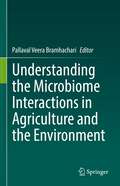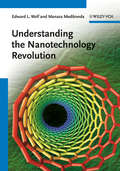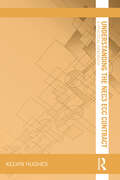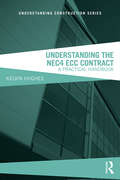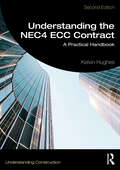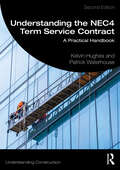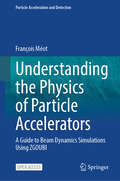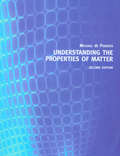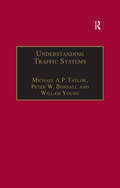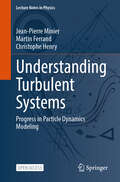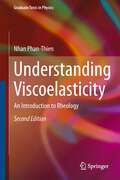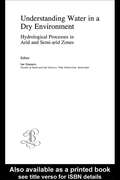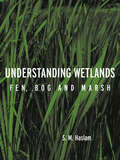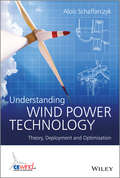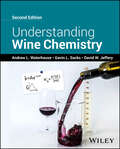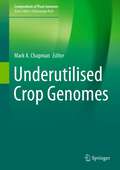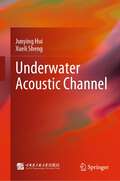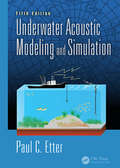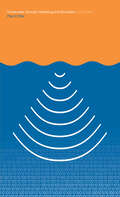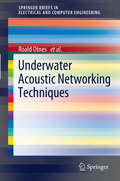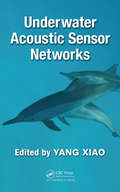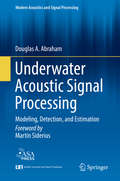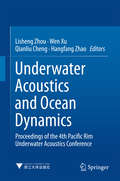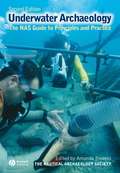- Table View
- List View
Understanding the Microbiome Interactions in Agriculture and the Environment
by Pallaval Veera BramhachariThis book illustrates the importance of microbiome interactions in sustainable agriculture and the environment. The chapters of the book provide information pertaining to the vast diversity of microbiomes in many ecosystems and their functional dynamics. The book also discusses bioremediation, space microbiomes, geo microbiomes, coral microbiomes, antibiotic resistomes, and rhizomicrobiome. It also sheds light on the complex syntrophic and other symbiotic interactions between bacteria, protists, plants, and certain animals in agricultural and environmental systems. The book, in turn, provides an understanding of the adaptation, resilience, and evolution of microbial ecosystems. Further, the chapters cover metagenomics analysis of microbiomes of a novel or extreme environments, microbial resilience or temporal fluctuations, symbiosis and co-evolution of the microbiome, and novel microbial interactions in agriculture and environment. Finally, the book elucidates a comprehensive yet representative description of complex structural and functional diversity within the plant and environmental microbiomes to reveal their immense potential. This book covers United Nations Sustainable Developmental Goal 2 towards Zero Hunger.
Understanding the Nanotechnology Revolution
by Edward L. Wolf Manasa MedikondaA unique introduction for general readers to the underlying concepts of nanotechnology, covering a wide spectrum ranging from biology to quantum computing. The material is presented in the simplest possible way, including a few mathematical equations, but not mathematical derivations. It also outlines as simply as possible the major contributions to modern technology of physics-based nanophysical devices, such as the atomic clock, global positioning systems, and magnetic resonance imaging. As a result, readers are able to establish a connection between nanotechnology and day-to-day applications, as well as with advances in information technology based on fast computers, the internet, dense data storage, Google searches, and new concepts for renewable energy harvesting. Also of interest to professionals working in law, finance, or teaching who wish to understand nanotechnology in a broad context, and as general reading for electrical, chemical and computer engineers, materials scientists, applied physicists and mathematicians, as well as for students of these disciplines.
Understanding the NEC3 ECC Contract: A Practical Handbook (Understanding Construction)
by Kelvin HughesAs usage of the NEC (formerly the New Engineering Contract) family of contracts continues to grow worldwide, so does the importance of understanding its clauses and nuances to everyone working in the built environment. Currently in its third edition, this set of contracts is different to others in concept as well as format, so users may well find themselves needing a helping hand along the way. Understanding the NEC3 ECC Contract uses plain English to lead the reader through the NEC3 Engineering and Construction Contract’s key features, including: main and secondary options the use of early warnings programme provisions payment compensation events preparing and assessing tenders. Common problems experienced when using the Engineering and Construction Contract are signalled to the reader throughout, and the correct way of reading each clause explained. The way the contract effects procurement processes, dispute resolution, project management, and risk management are all addressed in order to direct the user to best practice. Written for construction professionals, by a practicing international construction contract consultant, this handbook is the most straightforward, balanced and practical guide to the NEC3 ECC available. An ideal companion for employers, contractors, project managers, supervisors, engineers, architects, quantity surveyors, subcontractors, and anyone else interested in working successfully with the NEC3 ECC.
Understanding the NEC4 ECC Contract: A Practical Handbook (Understanding Construction)
by Kelvin HughesAs usage of the NEC family of contracts continues to grow worldwide, so does the importance of understanding its clauses and nuances to everyone working in the built environment. Understanding the NEC4 ECC Contract uses plain English to lead the reader through the NEC4 Engineering and Construction Contract’s key features. Chapters cover: The Contractor’s main responsibilities the use of early warnings Contractor’s design Tendering Quality management Payment Liabilities and insurance Termination Avoiding and resolving disputes and much more. Common problems experienced when using the Engineering and Construction Contract are signaled to the reader throughout, and the correct way of reading each clause explained. The way the contract effects procurement processes, dispute resolution, project management, and risk management are all addressed in order to direct the user to best practice. Written for construction professionals, by a practicing international construction contract consultant, this handbook is the most straightforward, balanced and practical guide to the NEC4 ECC available. An ideal companion for employers, contractors, project managers, supervisors, engineers, architects, quantity surveyors, subcontractors, and anyone else interested in working successfully with the NEC4 ECC.
Understanding the NEC4 ECC Contract: A Practical Handbook (Understanding Construction)
by Kelvin HughesAs usage of the NEC family of contracts continues to grow worldwide, so does the importance of understanding its clauses and nuances to everyone working in the built environment. This second edition of Understanding the NEC4 ECC Contract uses plain English to lead the reader through the NEC4 Engineering and Construction Contract’s key features. Chapters cover: Contractor’s main responsibilities The use of early warnings Contractor’s design Tendering Quality management Payment Liabilities and insurance Termination Avoiding and resolving disputes and much more.Common problems experienced when using the Engineering and Construction Contract (ECC) are signalled to the reader throughout, and the correct way of reading each clause explained. The way the contract effects procurement processes, dispute resolution, project management and risk management are all addressed in order to direct the user to best practice. This second edition takes into account the updates to the contract released in 2019, 2020 and 2023, and brings the book up to date with the most current practice.Written for construction professionals, by a practicing international construction contract consultant, this handbook is the most straightforward, balanced and practical guide to the NEC4 ECC available. An ideal companion for employers, contractors, project managers, supervisors, engineers, architects, quantity surveyors, subcontractors and anyone else interested in working successfully with the NEC4 ECC.
Understanding the NEC4 ECC Contract: A Practical Handbook (Understanding Construction)
by Kelvin HughesAs usage of the NEC family of contracts continues to grow worldwide, so does the importance of understanding its clauses and nuances to everyone working in the built environment. This second edition of Understanding the NEC4 ECC Contract uses plain English to lead the reader through the NEC4 Engineering and Construction Contract’s key features. Chapters cover: Contractor’s main responsibilities The use of early warnings Contractor’s design Quality management Payment Liabilities and insurance Termination Avoiding and resolving disputes Tendering Common problems experienced when using the Engineering and Construction Contract (ECC) are signalled to the reader throughout, and the correct way of reading each clause explained. The way the contract effects procurement processes, dispute resolution, project management and risk management are all addressed in order to direct the user to best practice. This second edition takes into account the updates to the contract released in 2019, 2020 and 2023, and brings the book up to date with the most current practice.Written for construction professionals, by a practising international construction contract consultant, this handbook is the most straightforward, balanced and practical guide to the NEC4 ECC available. An ideal companion for employers, contractors, project managers, supervisors, engineers, architects, quantity surveyors, subcontractors and anyone else interested in working successfully with the NEC4 ECC.
Understanding the NEC4 Term Service Contract: A Practical Handbook (Understanding Construction)
by Kelvin Hughes Patrick WaterhouseUse of the NEC4 suite of contracts continues to grow and the new edition of Understanding the NEC4 Term Service Contract includes significant additional materials and changes since its original publication immediately after the initial release of the NEC4 contracts. Experienced authors and construction contracts specialists Kelvin Hughes and Patrick Waterhouse have added numerous practical experiences, case studies, lessons learned and guidance notes which were not available at the time of writing the original book.Covering all the recent updates to the contract and written in plain English, Understanding the NEC4 Term Service Contract offers a practical guide to the use and management of the NEC4 Term Service Contract (TSC). The authors describe the full life of a contract, from the initial selection of options and contract formation through to the operations period and ultimately termination and dispute resolution. Although born of the same stable as the NEC4 construction contracts, the TSC is aimed at maintaining infrastructure and differs significantly from its siblings.This is essential reading for anyone working with the contracts and takes the reader through the important provisions including communications, planning, early warnings, compensation events and payments. It is ideal for clients, contractors and their advisors describing how to deploy the contract successfully.
Understanding the Physics of Particle Accelerators: A Guide to Beam Dynamics Simulations Using ZGOUBI (Particle Acceleration and Detection)
by François MéotThis open access book introduces readers to the physics of particle accelerators, by means of beam dynamics simulations and exercises using the computer code ZGOUBI. The respective chapters are organized chronologically and trace the historical development of accelerators from electrostatic columns to storage rings, to the numerous variations on resonant acceleration and focusing techniques, while also addressing side aspects such as synchrotron radiation and spin dynamics. The book offers computer simulations in which readers can manipulate, guide, and accelerate charged particles and particle beams in most types of particle accelerator. By performing these simulation exercises, they will acquire a deeper understanding of charged particle beam optics, accelerator physics and technology, as well as the why and how of when to use one technology or the other. These exercises guide readers through a virtual world of accelerator and beam simulations, and involve e.g. manipulating beams for cancer therapy, producing synchrotron radiation for condensed matter research, accelerating polarized ion beams for nuclear physics research, etc. In addition to acquiring an enhanced grasp of physics, readers will discover the basic theoretical and practical aspects of particle accelerators’ main components: guiding and focusing magnets, radio-wave accelerating cavities, wigglers, etc.
Understanding the Properties of Matter
by Michael de PodestaUnderstanding the Properties of Matter: 2nd Edition takes a unique phenomenological approach to the presentation of matter, materials, and solid-state physics. After an overview of basic ideas and a reminder of the importance of measurement, the author considers in turn gases, solids, liquids, and phase changes. For each topic, the focus is on "what happens." After a preliminary examination of data on the properties of matter, the author raises, then addresses a series of questions concerning the data. It is only in answering these questions that he adopts the theoretical approach to the properties of matter. This approach can reawaken in readers the fascination for the subject that inspired some of the greatest physicists of our age. Examples and extensive exercises reinforce the concepts. A supporting Web site furnishes for free download a plethora of additional materials, including:" Supplementary chapters on the band theory of solids and the magnetic properties of solids" Copies of all the data talbes used in the book, in PDF and spreadsheet formats" Enlarged copies of all figures" A simple molecular dynamics simulation" Animations uillustrating important featrues of key equations" Answers to the end-of-chapter exercisesUnderstanding the Properties of Matter is an entertaining and innovative text accessible at the undergraduate level.
Understanding Traffic Systems: Data Analysis and Presentation
by Michael A.P. Taylor Peter W. BonsallRoad traffic and its impacts affect all aspects of modern life, leisure and industry, with safety, congestion and pollution being of greatest public concern. Transport planning increasingly emphasises travel demand management (TDM) and traffic calming - aided by dynamic, lower cost data from Intelligent Transport Systems (ITS) - to enable real time monitoring, control and traveller information. This second edition of a highly successful work has been fully updated since its first publication in 1996 to reflect developments in technology available to the traffic analyst and in the social, ecological and economic environment. New sections are included on shockwaves, data capture without surveys, traffic incidents, delay estimation, off-line use of on-line data, environmental sensitivity, and controlled crash tests. The authors introduce and demonstrate techniques with which the analyst, engineer or planner can examine traffic problems. The underlying theme is that proper understanding of traffic systems performance and traffic problems can only come from the intelligent processing, refinement, appraisal and evaluation of traffic data. Arranged in five parts, the book offers an integrated approach to tackling road traffic problems: ¢ How to gain information and understanding about traffic ¢ The theories of traffic flow ¢ The principles of good survey planning and management ¢ Specific types of traffic studies ¢ Analytical techniques for transforming raw data into useful information. Understanding Traffic Systems provides cogent insights into the techniques of traffic data collection and analysis, the application of traffic theory and the role of data in analysis and decision making. Its breadth and use of examples from several countries make it a useful reference text for students and researchers, as well as an essential tool for practising traffic engineers and planners.
Understanding Turbulent Systems: Progress in Particle Dynamics Modeling (Lecture Notes in Physics #1039)
by Jean-Pierre Minier Martin Ferrand Christophe HenryThis open access book provides a thorough introduction to modeling turbulent, dispersed, two-phase flows. It explains the physical phenomena and governing laws at play, followed by a clear and systematic overview of the statistical tools used to develop simplified or coarse-grained models. With a pedagogical approach, the book uses practical examples to explain complex physical processes and stochastic methods, making it accessible to readers familiar with basic courses in statistical physics and applied mathematics. It also highlights emerging research areas and unexplored challenges in the field. Designed as a self-contained resource, this book is ideal for graduate students and junior researchers in various branches of physics. At the same time, it serves as a valuable reference for experts seeking deeper insights into turbulent, dispersed, two-phase flows.
Understanding Viscoelasticity: An Introduction to Rheology
by Nhan Phan-ThienThis book presents an introduction to viscoelasticity; in particular, to the theories of dilute polymer solutions and dilute suspensions of rigid particles in viscous and incompressible fluids. These theories are important, not just because they apply to practical problems of industrial interest, but because they form a solid theoretical base upon which mathematical techniques can be built, from which more complex theories can be constructed, to better mimic material behaviour. The emphasis is not on the voluminous current topical research, but on the necessary tools to understand viscoelasticity at a first year graduate level. The main aim is to provide a still compact book, sufficient at the level of first year graduate course for those who wish to understand viscoelasticity and to embark in modeling of viscoelastic multiphase fluids. To this end, a new chapter on Dissipative Particle Dynamics (DPD) was introduced which is relevant to model complex-structured fluids. All the basic ideas in DPD are reviewed, with some sample problems to illustrate the methodology.
Understanding Water in a Dry Environment: IAH International Contributions to Hydrogeology 23 (IAH - International Contributions to Hydrogeology)
by Ian SimmersIn order to provide water security in the twenty-first century, there is universal agreement that a continuation of current policies and extrapolation of trends is not an option. Also clear is that from both water supply and development perspectives, the world's arid and semi-arid regions are those currently and potentially experiencing the highest
Understanding Wetlands: Fen, Bog and Marsh
by S. M. HaslamWetlands are an important, and sadly diminishing, habitat in many parts of the world. They contribute significantly to the planet's biodiversity, housing thousands of species of plants and animals. Increasingly, human management is required to sustain, and even create these fragile ecosystems, while global changes in climate are also taking their t
Understanding Wind Power Technology
by Alois SchaffarczykWind energy technology has progressed enormously over the last decade. In coming years it will continue to develop in terms of power ratings, performance and installed capacity of large wind turbines worldwide, with exciting developments in offshore installations.Designed to meet the training needs of wind engineers, this introductory text puts wind energy in context, from the natural resource to the assessment of cost effectiveness and bridges the gap between theory and practice. The thorough coverage spans the scientific basics, practical implementations and the modern state of technology used in onshore and offshore wind farms for electricity generation.Key features: provides in-depth treatment of all systems associated with wind energy, including the aerodynamic and structural aspects of blade design, the flow of energy and loads through the wind turbine, the electrical components and power electronics including control systems explains the importance of wind resource assessment techniques, site evaluation and ecology with a focus of project planning and operation describes the integration of wind farms into the electric grid and includes a whole chapter dedicated to offshore wind farms includes questions in each chapter for readers to test their knowledgeWritten by experts with deep experience in research, teaching and industry, this text conveys the importance of wind energy in the international energy-policy debate, and offers clear insight into the subject for postgraduates and final year undergraduate students studying all aspects of wind engineering. Understanding Wind Power Systems is also an authoritative resource for engineers designing and developing wind energy systems, energy policy makers, environmentalists, and economists in the renewable energy sector.
Understanding Wine Chemistry (Sci (society Of Chemical Industry) Ser.)
by David W. Jeffery Andrew L. Waterhouse Gavin L. SacksUnderstanding Wine Chemistry Understand the reactions behind the world’s most alluring beverages The immense variety of wines on the market is the product of multiple chemical processes – whether acting on components arising in the vineyard, during fermentation, or throughout storage. Winemaking decisions alter the chemistry of finished wines, affecting the flavor, color, stability, and other aspects of the final product. Knowledge of these chemical and biochemical processes is integral to the art and science of winemaking. Understanding Wine Chemistry has served as the definitive introduction to the chemical components of wine, their properties, and their reaction mechanisms. It equips the knowledgeable reader to interpret and predict the outcomes of physicochemical reactions involved with winemaking processes. Now updated to reflect recent research findings, most notably in relation to wine redox chemistry, along with new Special Topics chapters on emerging areas, it continues to set the standard in the subject. Readers of the second edition of Understanding Wine Chemistry will also find: Case studies throughout showing chemistry at work in creating different wine styles and avoiding common adverse chemical and sensory outcomes Detailed treatment of novel subjects like non-alcoholic wines, non-glass alternatives to wine packaging, synthetic wines, and more An authorial team with decades of combined experience in wine chemistry research and education Understanding Wine Chemistry is ideal for college and university students, winemakers at any stage in their practice, professionals in related fields such as suppliers or sommeliers, and chemists with an interest in wine.
Underutilised Crop Genomes (Compendium of Plant Genomes)
by Mark A. ChapmanThis book highlights the uses for underutilized crops, presenting the state-of-the-art in terms of genome sequencing for over 30 crops, previously understudied and under-researched. In a changing climate and with significant pressure on the land, it is the ideal time to be discussing novel crops, with significant biotic and abiotic tolerances and/or rich nutrient profiles for consumers. Previously, the only species with sequenced genomes were high-profile internationally recognized crops, but in the current era genomes are being sequenced for dozens of crops, including those previously classified as underutilized, now being investigated. This book covers food crops, from fruits to tubers, and from grasses to legumes, as well as crops with non-food applications. Some of these crops have draft genomes, and others have polished genomes with extensive resequencing panels. Each chapter tells the story of an individual crop or crop group, written by experts, focusing on the genome data available, revealing more about crop domestication and genetic variation, and the current and future prospects given that this data is now becoming available. It also highlights how even small sequencing projects can provide draft genome sequences suitable for gene discovery, comparative genomics, and identification of molecular markers for understanding these crops further.
Underwater Acoustic Channel
by Junying Hui Xueli ShengThis book introduces sonar system and acoustic channel model, average energy channel, coherent multipath channel, the theoretical basis for the stochastic time-varying space-variant channel, slowly time-varying coherent multipath channel, and reverberation channel. Based on the basic theory of underwater acoustic channels and the various characteristics of the marine acoustic environment factor, this textbook aims to help students understand the impact of the marine acoustic channel on the sonar system. It helps students to grasp underwater acoustic signal processing principles and obtain the ability to solve practical problems in underwater acoustic channel engineering. Finally, it aims at laying a foundation for the further sonar system design. This textbook is recommended for graduate or undergraduate students in the field of sonar signal processing, underwater acoustic engineering, as well as some related subjects of marine technology.
Underwater Acoustic Modeling and Simulation
by Bernt S. AadnoyThis newest edition adds new material to all chapters, especially in mathematical propagation models and special applications and inverse techniques. It has updated environmental-acoustic data in companion tables and core summary tables with the latest underwater acoustic propagation, noise, reverberation, and sonar performance models. Additionally
Underwater Acoustic Modelling and Simulation
by P.C. EtterUnderwater Acoustic Modeling and Simulation examines the translation of our physical understanding of sound in the sea into mathematical models that can simulate acoustic propagation, noise and reverberation in the ocean. These models are used in a variety of research and operational applications to predict and diagnose the performance of complex s
Underwater Acoustic Networking Techniques
by Michael Goetz Paul Van Walree Roald Otnes Ivor Nissen Knut Rimstad Thor Husøy Alfred Asterjadhi Michele Zorzi Paolo CasariThis literature study presents an overview of underwater acoustic networking. It provides a background and describes the state of the art of all networking facets that are relevant for underwater applications. This report serves both as an introduction to the subject and as a summary of existing protocols, providing support and inspiration for the development of network architectures.
Underwater Acoustic Sensor Networks
by Yang XiaoA detailed review of underwater channel characteristics, Underwater Acoustic Sensor Networks investigates the fundamental aspects of underwater communication. Prominent researchers from around the world consider contemporary challenges in the development of underwater acoustic sensor networks (UW-ASNs) and introduce a cross-layer approach for effec
Underwater Acoustic Signal Processing: Modeling, Detection, And Estimation (Modern Acoustics and Signal Processing)
by Douglas A. AbrahamThis book provides comprehensive coverage of the detection and processing of signals in underwater acoustics. Background material on active and passive sonar systems, underwater acoustics, and statistical signal processing makes the book a self-contained and valuable resource for graduate students, researchers, and active practitioners alike. <P><P>Signal detection topics span a range of common signal types including signals of known form such as active sonar or communications signals; signals of unknown form, including passive sonar and narrowband signals; and transient signals such as marine mammal vocalizations. This text, along with its companion volume on beamforming, provides a thorough treatment of underwater acoustic signal processing that speaks to its author’s broad experience in the field.
Underwater Acoustics and Ocean Dynamics
by Lisheng Zhou Wen Xu Qianliu Cheng Hangfang ZhaoThese proceedings are a collection of 16 selected scientific papers and reviews by distinguished international experts that were presented at the 4th Pacific Rim Underwater Acoustics Conference (PRUAC), held in Hangzhou, China in October 2013. The topics discussed at the conference include internal wave observation and prediction; environmental uncertainty and coupling to sound propagation; environmental noise and ocean dynamics; dynamic modeling in acoustic fields; acoustic tomography and ocean parameter estimation; time reversal and matched field processing; underwater acoustic localization and communication as well as measurement instrumentations and platforms. These proceedings provide insights into the latest developments in underwater acoustics, promoting the exchange of ideas for the benefit of future research.
Underwater Archaeology: The NAS Guide to Principles and Practice
by Nautical Archaeology Society (NAS)Underwater Archaeology: The NAS Guide to Principles and Practice provides a comprehensive summary of the archaeological process as applied in an underwater context. Long awaited second edition of what is popularly referred to as the NAS Handbook Provides a practical guide to underwater archaeology: how to get involved, basic principles, essential techniques, project planning and execution, publishing and presenting Fully illustrated with over 100 drawings and new colour graphics New chapters on geophysics, historical research, photography and video, monitoring and maintenance and conservation
